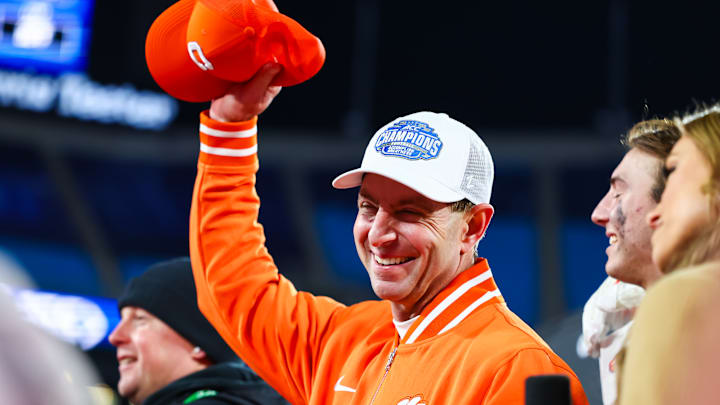Josh Pate has never been one to shy away from making bold claims about the state of college football, and his recent assessment of Clemson's future is no different.
The 247Sports analyst raised concerns about the Tigers' trajectory, pointing specifically to the 2025 recruiting class, which ranked 26th nationally—Clemson’s lowest-ranked class since 2010.
While Pate acknowledged that Clemson could still be competitive in 2025, he suggested that the Tigers are falling behind powerhouse programs like Texas and Ohio State.
"They're not close. Let me put it plainly: Clemson's football players that they are accumulating are not going to be good enough to meet the standard they've set there," Pate said. "Unless something drastic changes or unless their development laps the rest of the sport or the recruiting rankings were just totally flawed. Unless something like that is amiss, they're not going to be able to keep up. This year's team will actually be their best shot over the next several years. That's the way it looks to me right now. I would be happy to be sold on the alternative."
However, there are some key details he left out that provide a more complete picture of where Clemson is actually headed.
The reality behind Clemson's smaller recruiting class
Pate's primary concern stems from Clemson’s recruiting ranking, but the context behind that ranking is crucial. The 2025 class was small—not because Clemson struggled to land recruits, but because there simply weren’t many spots available. Clemson returned nearly all of its starters on both sides of the ball, including nine on offense and 11 players with starting experience on defense, which naturally limited the number of scholarships available.
Unlike programs that experience high turnover and need to reload with large recruiting classes, Clemson is retaining its talent at an elite level. The Tigers had one player projected to be on the two-deep transfer out in WR Troy Stellato, and one rotational piece in DE A.J. Hoffler. That's it.
Dabo Swinney remains one of the best coaches in the country at keeping his players in-house, a rare skill in the current transfer-heavy landscape. Rather than relying on massive recruiting hauls every cycle, he has built a foundation that keeps experienced players in the system longer, allowing for internal development to remain a strength of the program.
Clemson's coaching staff is getting stronger
Another aspect that Pate glossed over is Swinney’s willingness to adapt and bring in proven coaching talent, which is something that was badly needed after Swinney attempted to promote from within in previous years.
The addition of former Indiana head coach Tom Allen as Clemson’s new defensive coordinator—poaching him from Penn State—shows that Swinney isn’t just sitting back and hoping his system works, at least not anymore. Allen brings a wealth of experience, and his defensive schemes could be exactly what Clemson needs to get back to its defensive dominance.
On the offensive side, Swinney made another strategic hire last offseason by bringing in Matt Luke, a well-respected offensive line coach with SEC experience, to bolster the trenches. He immediately made a difference in developing the offensive line.
These are not the moves of a coach unwilling to evolve. Instead, they prove that Swinney is actively making changes to ensure Clemson stays competitive.
Moreover, Clemson has built an elite support staff, rivaling some of the best in the country, including Mike Houston and Lonnie Galloway this offseason. Oh, and Clemson just brought in Kevin Kelly from the Los Angeles Chargers to serve as the program's Director of Player Evaluation & Acquisition.
The Transfer Portal narrative needs updating
For years, critics claimed that Swinney refused to embrace the transfer portal, but that narrative no longer holds water.
While Clemson hasn’t used the portal as aggressively as some programs, the Tigers have strategically brought in talent where needed, including former Purdue defensive end Will Heldt. They also brought in a 6-foot-5 wide receiver in Tristan Smith from Southeast Missouri State and former 5-star EDGE/LB Jeremiah Alexander from Alabama.
Could Clemson do better in the portal? Absolutely. We think that would be the reasoning for bringing in Kevin Kelly.
Looking Beyond 2025
Pate may be hitting the panic button on Clemson, but his take seems short-sighted. The real indicator of Clemson’s recruiting trends will be the 2026 cycle, where the Tigers will have significantly more scholarships to offer. Even with a smaller 2025 class, Clemson’s average player rating remained relatively strong, ranking 17th on On3's per-commit basis.
Is Clemson guaranteed to be a top-tier contender every single year? No program is. But the idea that the Tigers are falling off a cliff ignores Swinney’s track record and all the changes he's been willing to make in the last couple of years, particularly this offseason.
The 2025 season may be a critical one for Clemson, but the foundation is far from crumbling. Will the Tigers be competing for a national title every year? No, but there's still nothing to indicate currently that Clemson won't remain the class of the ACC and continue to compete for College Football Playoff berths — especially with the expanded field — more years than not.
